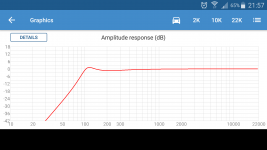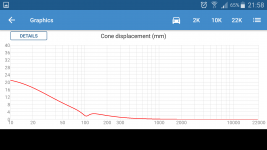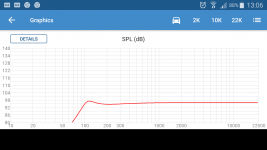Hi , i have been reading on the internet about subsonic filters. In my opinion it have 2 advantages.
1. It will reduce excursion off the speaker.
2. I will cost less energy because low tones will be gone.
The problem is that I can't find some filters. Does somebody know something about It.
1. It will reduce excursion off the speaker.
2. I will cost less energy because low tones will be gone.
The problem is that I can't find some filters. Does somebody know something about It.
I believe you mean infrasonic filter, also known as rumble filters. They will not reduce the bass unless you actually mean a high pass filter (higher up the frequency spectrum), which will do what it sounds like you want. They can be a s simple as a cap and coil or you have the option of going active (powered by electricity)
I believe you mean infrasonic filter, also known as rumble filters. They will not reduce the bass unless you actually mean a high pass filter (higher up the frequency spectrum), which will do what it sounds like you want. They can be a s simple as a cap and coil or you have the option of going active (powered by electricity)
Thanks for the info. If I use a cap and coil it will decrease bass but not the power because the bass won't go tru the speaker but it will tru the cap and coil.
If I do it active I change the input signal on the amplifier and will me cost less energy.
Correct me if i'm wrong
Greetz
If I use a cap and coil it will decrease bass but not the power because
the bass won't go tru the speaker but it will tru the cap and coil.
Capacitors and inductors are reactive (current and voltage are 90 degrees apart),
and so ideally dissipate no power. It is good though, to filter the bass before the amplifier.
Last edited:
Also i have to say why i want to know this. I want to make a bleutooth mobile speaker that can as loud as possible. So i want to get rid of unneeded excursion and power. I want to highpass at 80 hz
I want to make a bleutooth mobile speaker that can as loud as possible.
So i want to get rid of unneeded excursion and power. I want to highpass at 80 hz
Good idea.
Last edited:
Why would you what a cut off at 80 hz, bass & male voices go down lower that that
" Men can sing to a low D (one note below a standard pitch guitar's bass string), which is about 73 - 74 Hz"?? Cheers
Because the speaker I want to use is 2 inch
You mean bigger speaker or higher fs?
There's no way that a 2" driver can go down to 80Hz, and be loud about it.
Last edited:
Attachments
Can go up to 98db
Better buy just one for testing first, it might be disappointing.
Can't see '98' on those graphs ?
Can't see '98' on those graphs ?
Actually it will not reach 98 db at 20 watt but if I give them 100 watt it will reach 97 db. All the graphs on this forum are taken with 100 watt.
Attachments
Last edited:
Actually it will not reach 98 db at 20 watt but if I give them 100 watt it will reach 97 db. All the graphs on this forum are taken with 100 watt.
Ah that's the sort of plot I was expecting 🙂
But, to be clear, you are pushing '100W' into a single 2 inch driver ?
OK if they are Chinese watts.
The spec says rated power 10W and maximum power 20W. I assume that means that at 10W it begins to overheat and at 20W it falls apart. I find even those figures hard to believe for a 2" driver.
PS it describes itself as a 'subwoofer'. Something which starts from as high as 75Hz is a woofer; if it were any higher it would be midrange.
The spec says rated power 10W and maximum power 20W. I assume that means that at 10W it begins to overheat and at 20W it falls apart. I find even those figures hard to believe for a 2" driver.
PS it describes itself as a 'subwoofer'. Something which starts from as high as 75Hz is a woofer; if it were any higher it would be midrange.
Last edited:
OK if they are Chinese watts.
The spec says rated power 10W and maximum power 20W. I assume that means that at 10W it begins to overheat and at 20W it falls apart. I find even those figures hard to believe for a 2" driver.
PS it describes itself as a 'subwoofer'. Something which starts from as high as 75Hz is a woofer; if it were any higher it would be midrange.
Maybe the good old 'Music Power' watts as beloved of many 'Computer Speakers' 🙂
Have to wonder what max cone excursion theyy have ?
Last edited:
OK if they are Chinese watts.
The spec says rated power 10W and maximum power 20W. I assume that means that at 10W it begins to overheat and at 20W it falls apart. I find even those figures hard to believe for a 2" driver.
PS it describes itself as a 'subwoofer'. Something which starts from as high as 75Hz is a woofer; if it were any higher it would be midrange.
If I put a highpass filter on it ( between 60 and 80hz) a lot of power is going away, also 100 watt is a bit to far but 50 watt must be possible
50W to a driver unit which claims 20W max will lead to a short and spectacular life. You have read the datasheet?
to the OP:
I don't really understand what you mean by '100W'.
ie are you filtering the pre amplifier signal or at the speaker itself ?
What is the signal - White / Pink Noise ?
How do you know it's '100W' ?
Not meaning to be over critical - I get that you want to filter out the bottom end as lots of energy there which won't be reproduced by the speaker and is a danger to it. I do the same thing on a different scale with bass guitar amplification to cut out the 'thumps' etc.
I don't really understand what you mean by '100W'.
ie are you filtering the pre amplifier signal or at the speaker itself ?
What is the signal - White / Pink Noise ?
How do you know it's '100W' ?
Not meaning to be over critical - I get that you want to filter out the bottom end as lots of energy there which won't be reproduced by the speaker and is a danger to it. I do the same thing on a different scale with bass guitar amplification to cut out the 'thumps' etc.
- Status
- Not open for further replies.
- Home
- Source & Line
- Analog Line Level
- Subsonic filter 80 hz


